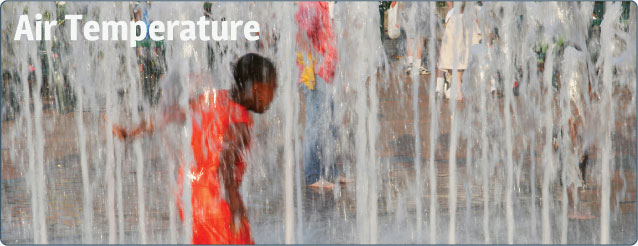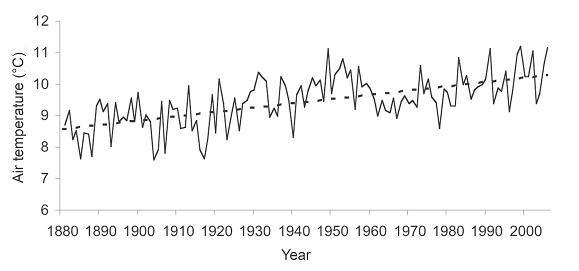
Climate Science: Air Temperature
Should I bring a sweater?
As you can imagine, increased air temperatures are critical contributors to climate change.
The Trends of Temperature
Evidence collected over the past century shows that temperatures have been increasing locally and globally. Moreover, the rate of increasing temperatures has also intensified in the second half of the century and is predicted to continue rising.
Since 1900 the annual average temperature has risen in the Northeast with the majority of warming occurring in the past few decades. Winter temperatures are rising faster than the overall mean or average temperature.
In Rhode Island, National Weather Service data in Providence follow the trend of greater increases in the second half of the last century.

Annual mean air temperature in the Rhode Island region from 1881 to 2007
6°C = 43°F and 12°C = 54°F (make more conversions)
In brief, it’s getting hotter. Now remember, this is the overall average temperature of the Earth, not the day-to-day weather patterns.
What are the impacts of higher air temperatures?
In the past five years, we have experienced severe winter storms. This is ironically more indicative of climate change than is an occasional mild winter. Sure, this seems topsy-turvy but climate change is more likely to produce erratic weather than simply warming weather. Severe storms are a more predictable part of changing global weather patterns.


Urban Heat Islands: John Frederick of the University of Chicago hopes to discover more about the health effects of particulate matter, such as its relationship to incidents of asthma and a warming trend known as the heat island effect.
It’s no wonder we are confused. But the truth is that climate change leads to irregular weather patterns brought on by an overall increase in global temperature. While the frequency of storms may not increase, their severity will. In Rhode Island, we have experienced recent spates of blizzards instead of traditional winter storms, and deluges that result in flood conditions rather than the accustomed April showers that bring May flowers. Instead we are finding that conditions are worsening and we’re on the receiving end of increasingly severe impacts.
Higher air temperature also alters the timing of seasonal conditions, lengthening the amount of time with warmer temperatures and shortening the amount of time with air that freezes your face. As local Rhode Island media have warned, the Narragansett Bay area climate may soon resemble that of the Chesapeake Bay. Consider what that means for all those fish we like to catch that need a colder environment to thrive. Will Rhode Islanders give up lobsta’ rolls for soft-shelled crabs? And with ocean acidification, both may be in jeopardy.
Is climate change all bad? Well, the impact of climate change may have some benefits for tourism and recreation, fishing, and other activities that are more easily conducted in warmer weather. A longer and warmer summer may prove a boon to luring visitors to Rhode Island’s beaches and recreational activities, and fill our marinas with out-of-state boaters and their crews. Farmers may also prosper from a longer growing season — assuming that season does not have extremes of weather ranging from rot-inducing deluges to crop shriveling droughts.
On the other hand, there is a downside. Sugar maples won’t grow in warmer climes — there go maple syrup and a good portion of leaf-peeping. “Phenology,” or changes in timing, is of major concern to scientists. What that means is birds that migrate from South America may arrive just past the point that their favorite fat caterpillars have emerged from their cocoon. The result: birds go hungry and the gypsy moths get a head start on denuding our trees and shrubs.
“It’s hot in here at night, lonely black and quiet on a hot summer night/ Don’t be afraid of the world we made on a hot summer night/ Hot in the city, hot in the city tonight”
- Billy Idol, Hot in the City
“It’s getting hot in herre.”
- Nelly
News
Factoids
Global average temperatures are expected to increase by 2-7°F by 2100, resulting in widespread food and water shortages and drought.
The period from January-July 2012 was the warmest such period on record for the Northeast US.
The number of local monthly heat records is currently 3 times higher than would be possible without human-induced climate change.
By 2050, cities in the US Northeast will likely have 70% more extreme heat days and 25% more heat related deaths.




